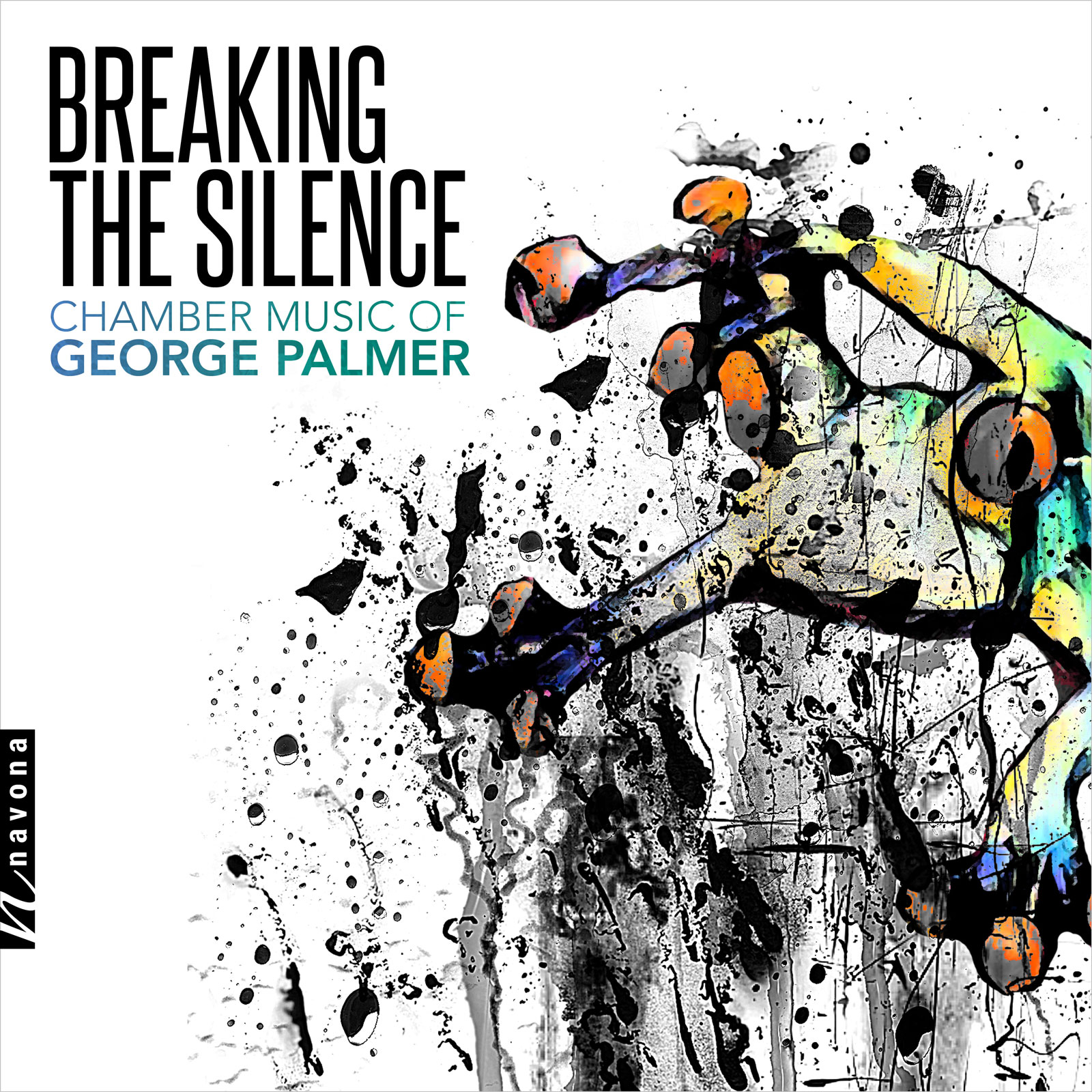Breaking the Silence
George Palmer composer
Navona Records proudly presents BREAKING THE SILENCE from legendary Australian composer George Palmer. The works featured on this new album draw inspiration from centuries-old poetry as well as the composer’s own life experience; Breaking the Silence unpacks a 17th-century pastoral haiku depicting a lone frog’s leap into a still pond, while Not Going Quietly is a touching tribute to a concert pianist whose life was cut short by a brain tumor.
Palmer’s versatility is on full display in this latest collection, with pieces arranged for chamber orchestra, clarinet and string quartet, and oboe and piano. A triumph of contemporary composition and modern recording, BREAKING THE SILENCE is at once approachable and universally captivating.
Listen
Stream/Buy
Choose your platform
"Often beautiful, with plenty of heart and substance"
Track Listing & Credits
| # | Title | Composer | Performer | |
|---|---|---|---|---|
| 01 | Cello Concerto "Breaking the Silence": I. Meditation - Frog Jumps In | George Palmer | Verbrugghen Ensemble | John Lynch, director; Catherine Hewgill, solo cello | 7:47 |
| 02 | Cello Concerto "Breaking the Silence": II. Old Pond | George Palmer | Verbrugghen Ensemble | John Lynch, director; Catherine Hewgill, solo cello | 7:43 |
| 03 | Cello Concerto "Breaking the Silence": III. Water's Sound | George Palmer | Verbrugghen Ensemble | John Lynch, director; Catherine Hewgill, solo cello | 7:04 |
| 04 | Ithaca | George Palmer | Francesco Celata, clarinet; Andrew Haveron, violin; Sandro Costantino, viola; Timothy Nankervis, cello | 10:11 |
| 05 | String Quintet "Not Going Quietly": I. — (Live) | George Palmer | Katie Chilmaid, violin; Emma Long, violin; Jacqui Cronin, viola; Rowena Crouch, cello; David Campbell, double bass | 5:36 |
| 06 | String Quintet "Not Going Quietly": II. — (Live) | George Palmer | Katie Chilmaid, violin; Emma Long, violin; Jacqui Cronin, viola; Rowena Crouch, cello; David Campbell, double bass | 4:25 |
| 07 | String Quintet "Not Going Quietly": III. — (Live) | George Palmer | Katie Chilmaid, violin; Emma Long, violin; Jacqui Cronin, viola; Rowena Crouch, cello; David Campbell, double bass | 5:09 |
| 08 | Time Out: I. Sunset (Lake Albert) | George Palmer | Shefali Pryor, oboe; Jeanell Carrigan, piano | 4:40 |
| 09 | Time Out: II. First Light, Briefly (Centennial Park) | George Palmer | Shefali Pryor, oboe; Jeanell Carrigan, piano | 2:25 |
| 10 | Time Out: III. 2 AM (Sydney Harbour) | George Palmer | Shefali Pryor, oboe; Jeanell Carrigan, piano | 4:12 |
Recorded September 18, 2015 at Trackdown Studios in Sydney, Australia
Recording Session Producer Philip Powers
Recording Session Engineer Bob Scott
Recorded November 21, 2016 at Studio 301 in Sydney, Australia
Recording Session Producer Philip Powers
Recording Session Engineer Bob Scott
Live concert recording September 16, 2007 at Paddington Uniting Church in Sydney, Australia
Sound Engineer Greg Ghavalas
Recorded July 6, 2020 at Electric Avenue, Pyrmont in Sydney, Australia
Sound Engineer Bob Scott
Executive Producer Bob Lord
Executive A&R Sam Renshaw
A&R Director Brandon MacNeil
A&R Chris Robinson
VP, Audio Production Jeff LeRoy
Audio Director Lucas Paquette
Mastering Shaun Michaud
VP, Design & Marketing Brett Picknell
Art Director Ryan Harrison
Design Edward A. Fleming
Publicity Patrick Niland, Sara Warner
Artist Information

George Palmer
Australian composer George Palmer (b.1947) studied piano with several eminent teachers and has been composing since he was a teenager. However, he graduated in law, practiced as a barrister, and in 2001 was appointed as a Judge of the Supreme Court of New South Wales. He retired as a Judge in 2011 to devote himself entirely to composition.
Catherine Hewgill
Australian cellist CATHERINE HEWGILL studied with Mstislav Rostropovich before touring Europe with I Solisti Veneti. Returning to Australia, Hewgill joined the Australian Chamber Orchestra and, in 1990, was appointed Principal Cello of the Sydney Symphony Orchestra. She has performed as soloist with the SSO under the baton of Dimitri Ashkenazy and Charles Dutoit and with the Australian World Orchestra under Zubin Mehta and Sir Simon Rattle. Hewgill plays a 1729 Carlo Tononi cello.
John Lynch
American-born JOHN LYNCH is an international conductor, having performed throughout the Americas, Europe, Asia, and Australia. He is the recipient of the American Prize and is presently a member of the conducting faculty at The Sydney Conservatorium of Music.
Andrew Haveron
ANDREW HAVERON is Concertmaster of the Sydney Symphony Orchestra and is one of the most sought-after violinists of his generation. In 2007 he became Concertmaster of the BBC Symphony Orchestra. As a soloist, he has performed with conductors such as Colin Davis, Roger Norrington, Jiri Belohlavek, and David Robertson. From 1999 to 2007, Andrew was first violin of the internationally acclaimed Brodsky Quartet and he has appeared with many eminent chamber ensembles around the world. Haveron plays a 1757 Guadagnini violin.
Francesco Celata
FRANCESCO CELATA is Associate Principal Clarinet of the Sydney Symphony Orchestra and has performed frequently as soloist throughout Australia and New Zealand and as Guest Principal Clarinet with the London Philharmonic Orchestra and Principal Clarinet with the Australian World Orchestra, under conductors such as Lorin Maazel, Ricardo Muti, Sir Simon Rattle, Zubin Mehta, Vladimir Ashkenazy, and Charles Dutoit.
Sandro Constantino and Timothy Nankervis
SANDRO COSTANTINO (viola) and TIMOTHY NANKERVIS (cello) are members of the Sydney Symphony Orchestra. Nankervis is also a member of the highly acclaimed Seraphim Trio.
Shefali Pryor
SHEFALI PRYOR is Associate Principal Oboe of the Sydney Symphony Orchestra and has performed as soloist with orchestras around Australia and in New Zealand. She is also a teacher at the Sydney Conservatorium of Music.
Dr. Jeanell Carrigan, AM
DR. JEANELL CARRIGAN, AM (piano) is Associate Professor in the Collaborative Piano Unit at the Sydney Conservatorium of Music. She has performed throughout Australia and Europe as a soloist, chamber musician, and collaborative duo partner. She has recorded many albums of Australian piano music.

